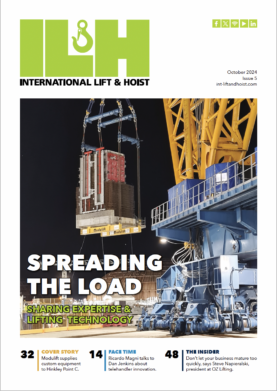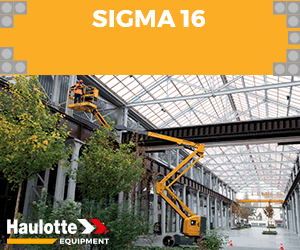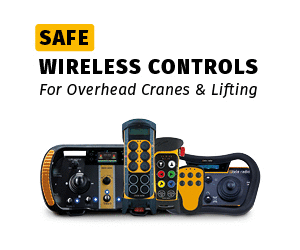How Designing Construction Equipment for the Armed Forces Benefits Consumers
Aiding the men and women who serve our country are military machines. Tanks and planes jump to mind first, but there are also other pieces of equipment used in reconstruction and rehabilitation efforts. Telehandlers, forklifts, scissor lifts, boom lifts, and cranes are placed around the world, supporting our men and women in uniform.
In the construction world, military contracts are prized above many other agreements. These often long-term deals are public announcements of a company's success and often come with large dollar amounts attached to them. On June 8, 2006, four Terex Demag MAC 50s were turned over to the Marines for testing and trials. The Marines have an option to buy up to 130 of the machines with a potential price tag of $88.6 million. But, in most cases, the military does not simply buy the product “off-the-shelf." Military machines must be versatile enough to perform non-typical work functions, fast enough to keep up with a moving convoy, and tough enough to provide protection for the operator.
Manufacturers looking to meet these needs aren't left in the dark about the requirements. Most branches of the service produce guidelines for manufacturers to follow. David Peacock, vice president of JLG's Government Products and Programs used the Army as his example. He stated that the Army gives manufacturers what they call a “PD” (Purchase Description), which outlines every single specification they want the machine to have.
“They have every function, every need, every desired variable written down in the PD,” said Peacock. The Army and JLG worked together to engineer and develop the All Terrain Lifter Army System (ATLAS), which is a telehandler built exclusively for the Army and the Army Reserve. As with all machines in the military, the ATLAS was required to be highly mobile. This JLG machine has a top speed of 23 miles per hour and can be transported via land, sea, or air.
Chris Saucedo, JCB's general manager of Military Products, echoed that statement. “Most military organizations define exactly what they are looking for in a product in terms of specification and capabilities,” he said. “The only thing we have to do as a contractor is meet their requirements.”

The engineering challenge
While this may sound easy, the engineers of the equipment would disagree with you. Designing equipment for military use often means adding more armor, torque, or horsepower, and this means added weight. Saucedo looked at one of his most recent design project challenges. “Basically, we were trying to turn your basic piece of equipment, in this case a backhoe, into a high mobility machine that would cruise at 60 mph on the road," he said. "When we added all the other mobility factors such as air transportability, stability, and top that off with upwards of 5,000 pounds of armor and we got some unique challenges. The armor alone weighed twice as much as most cars.”
When designing the sort of heavy-duty machines necessary for a military environment, companies still observe the basic standards and regulations of the industry.
“We follow the standards that the military demands in their purchase description,” Saucedo said. “This could be anything from ANSI, SAE, ISO, Military Standards (MIL-STD), NATO Standards (STANAGs) etc. This may sound easy enough, but the art of the business lies in understanding the interdependence of all these guidelines and designing a machine or a product that meets the constantly changing needs of the world's military while still adhering to the standards.”

Service contracts
Building the equipment is only one of the challenges. Service and the warranties included in the military contracts are what really keep the military's equipment moving. Peacock explains that the military's approach to service has changed dramatically in the last 10 years.
“Our first ATLAS machines were completed in 1996 and the thought process of the military, in those days, was to simply have a warehouse full of spares on hand,” he said. “Essentially, the military would buy 200 engines and put them on a shelf or in a warehouse somewhere. We didn't know what was exactly occurring with the machines until the officers called us and were in desperate need for a new part.”
But now, instead of basic warranties of one to two years, some contracts are lengthy and include clauses to provide 48-hour parts and service support anywhere in the world. Peacock added that the government pays a set fee to the OEMs to continue this service.
“It really changed the way we worked with the military and how we thought about the support and maintenance of our machines,” he said. “It's made us better as a company, not only for military [customers], but with basic commercial services as well.”
But, the military does not simply call into the companies every time they have a problem. “Most military organizations maintain their own equipment and have very robust logistics and maintenance capabilities,” Saucedo said. “For obvious reasons, the military has to be self sufficient in terms of maintenance."
Servicing machines can often be an adventure as well. Jon Bloch, Terex's Military Support and Service Coordinator, laughed about the experiences he'd had with service calls in forward locations. He enjoyed working with the service men, and loved their work-ethic and attitude. “It's like any workplace, the men run the gamut on their levels of expertise," he said. "But these guys do anything to help you. They want to get to know the machine as well as you do, so they can work on their machines and fix them further down the road.”
The relationship between the military and OEM doesn't always stop at the end of the machine's life span. Instead of simply buying new machines, the government often chooses to refurbish the machines. One recent example of this was the agreement reached between Case and the United States Army, resulting in a $15.5 million contract to rebuild the manufacturer's forklifts.

The benefit to consumers
So what do these profitable military contracts mean to the average construction equipment consumer?
Despite the hesitancy of many to look past the cost to the tax-payers, there is some very redeemable value to the commercial consumer in these contracts. Manufacturers learn quickly when dealing with these high-pressure jobs, and they learn new ways to create bigger and better machines by exposing themselves to the rigor of these military contracts. As David Peacock said, manufacturers have streamlined their service capabilities and are now extending the type of ideals they set with their military warranties into commercial contracts. Technological advances seem to come on the heels of military successes as well. The more push there is from the military for a manufacturer to achieve a certain kind of machine, the greater the chances of the consumer seeing it as well.
On July 26, 2006, the first CareLift Zoom Boom 32032 was delivered to the Navy. While this machine was designed specifically for the Navy and Navy use, CareLift has made the model available to the general public. Guy Ramsey had the opportunity to review the ZB32032 and stated that “smooth, precise control makes operating this massive machine a snap” and “phenomenal lifting capabilities put the ZB32032 in a class by itself.” To read the whole review, click here.
And that's what contractor's need, new machines that they can fit to any job. They need the machine that is “in a class by itself” to further the speed of their job site. Without the military, many of these advancements would be long overdue.











